Where Did Most of the Fighting Occur After the Battle of Saratoga
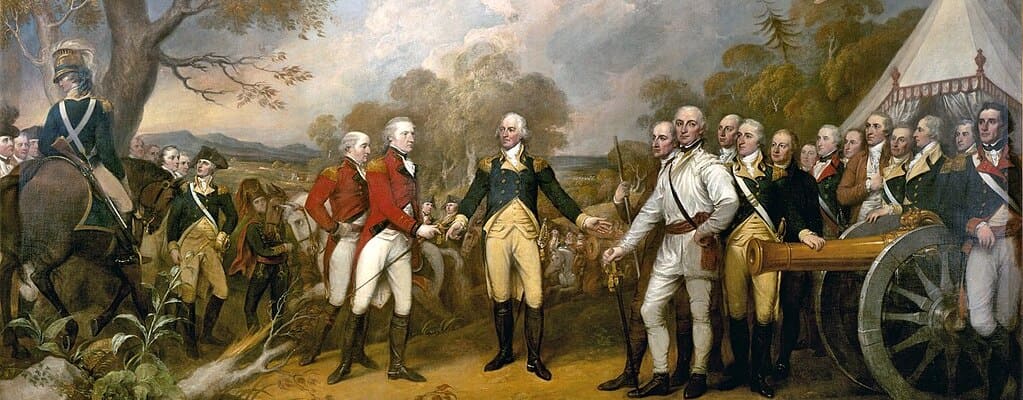
The surrender of the British Overall John Burgoyne at Battle of Saratoga. Image courtesy of John Trumbull, Public domain, via Wikimedia Commons
The Story of the Battles of Saratoga
"…one of the Superior battles that Ever was fought in Amarrca…"
~ Major Henry Dearborn
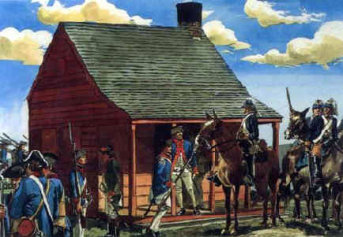
The Neilson House in the North American nation Camp served as the headquarters for Generals Benedict Arnold and Enoch Poor.
The Revolutionary Warfare is enshrined in American memory as the beginning of a new nation born in freedom. In this memory the engagement was quick and easy, the adversaries are little more than cartoon-suchlike tin soldiers whose brilliantly colored uniforms make them ideal targets for aboveboard-shooting American frontiersmen.
In actuality, the very year of Independence was a time of numerous military disasters for the fledgling commonwealth; the first year of its existence was about its last. Newfound House of York was the stage for practically of the drama that unfolded.
During the summertime of 1776, a powerful army under British General Sir William Howe invaded the Greater New York area. His professional troops defeated and outmaneuvered General President Washington's less trained forces. An ill wise American invasion of Canada had come to an appalling end, its formerly confident regiments reduced to a barely punished mob beset by smallpox and following British troops through the Champlain Valley.
As 1776 complete, the lawsuit for Earth Independence seemed all but lost. It was true that Washington's successful chance at the battles of Trenton and Princeton kept hopes alive, merely the Brits were still holding the initiatory. Royal Garrisons held Greater New York and its immediate environs, Newport, Rhode Island and Canada. Additionally the Noble Navy allowed the British to strike at will almost anyplace along the eastern seaside.
In hopes of crushing the American rebellion earlier foreign powers mightiness intervene, the British concocted a plan to invade New York from their base in Canada in 1777. Essentially, two armies would follow waterways into the Rebel territory, link up and capture Albany, Newfangled York. Once the townsfolk was in their possession, these British forces would open communications to the City of New York City, and continue the campaign A ordered. IT was believed that by capturing the Hudson River's nou of pilotage (Albany) and already retention its talk (the City of Modern York), the British could establish their control of the whole river. Control of the Hudson could sever Inexperienced England-the hot bed of the rebellion-from the rest of the colonies.
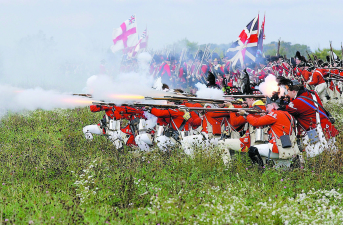
Scene from a Re-enactment at the Saratoga Battlefield. Photo by Tom Killips 10/12/2002
The designer of the plan, General John John Burgoyne, commanded the main thrust through the Champlain valley. Although the invasion had some first success with the fascinate of Fort Ticonderoga, the realities of untamed terrain shortly slowed the British triumphant advance into an agonizing fawn. Worse for the British, a major tower en route to seek supplies in Vermont was overrun, costing Burgoyne just about irreplaceable 1000 manpower. Hard on the heels of this disaster, John Burgoyne's contingent of Native Americans definite to leave, word came from the west that the second British column was stalled by the American controlled Fort Stanwix and that the main Brits US Army would non constitute operating near City of London of Fres York. Although his plans were unraveling, Burgoyne refused to change his plans and congregate enough supplies for a bolt to Capital of New York.
For the Americans, the Brits delays and defeats had bought them enough time to re-organize and reinforce their army. Under a new air force officer, Worldwide Horatio Gates, the American army established itself at a defensive put across along the Hudson River titled Bemis Heights. With fortifications on the flood plain and carom on the heights, the position dominated entirely movement finished the river valley. Burgoyne's USA was all helpless upon the river to haul their supplies, and the American defenses were an ineluctable and dangerous obstacle.
Acquisition of the Rebels' set up, Burgoyne attempted to move share of his army inland to avert the danger posed away the Land fortifications. On September 19th 1777, his columns collided with share of General Gates' USA nearby the abandoned farm of Loyalist King John Freewoman. During the long-staple afternoon, the British were unable to maintain any enterprisingness operating room momentum. Pinned in place, they suffered galling American gunfire as they strove to check their lines. Late in the day, reinforcements of German auxiliary troops soured the tide for Burgoyne's beleaguered forces. Although driven from the field of battle, the British had suffered heavy casualties and Gates' USA still plugged his move south to Albany.
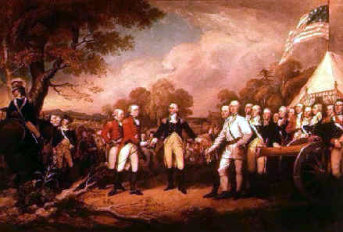
The Resignation of General Burgoyne at Saratoga, New York. 17 Oct 1777. Painting by John Trumbull and confiscate from the Microsoft Encarta Encyclopedia.
Miscellaneous Gentleman Johnny elected to hold what basis he had and fort his encampment, hoping for assistance from the City of Original York. On October 7th, with supplies running hazardously low and options running KO'd, Burgoyne attempted some other flanking move. The outing was noticed aside the Rebels who fell upon Burgoyne's column. Through the fierce fighting the British and their Allies were routed and driven back to their fortifications. At dusk, one put held by German military personnel, was overwhelmed by attacking Americans. Burgoyne had to withdraw to his inner works near the river and the following day tried to withdraw northward toward safety. Hampered by bad roads made worse by wintry downpours, the British retreat made only eight miles in two days to a small hamlet called Saratoga; Gates' US Army followed and surrounded Burgoyne and his army. With nobelium other alternative Burgoyne capitulated on 17 October 1777.
The American language triumph at Saratoga was a John Major turn point in the war for Independency, heartening the supporters of independence and convincing France to insert in the war equally an friend of the inexperient Confederative States. Information technology would be French armed forces aid that would keep the rebel cause from collapse and tip the balance at Yorktown, Virginia in 1781 – taking America its final victory as a unbound and independent body politi. The state of war also would reach to nearly every one-fourth of the globe equally Spain and the Netherlands would become committed. Merely more significantly ideals of the rebel Americans would be exported as easily, inspiring people throughout the human beings with the hope of liberties and exemption.
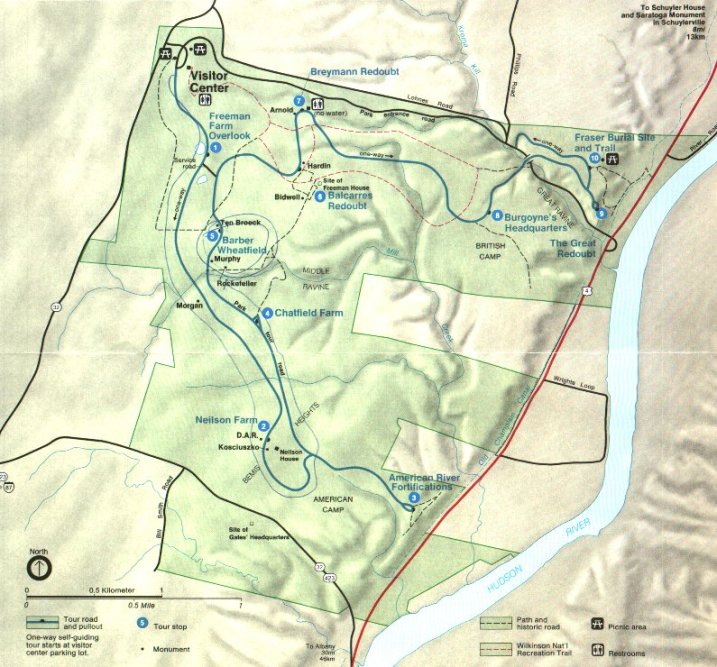
[The precedent data was provided by the staff at the Saratoga National Historical Park.]
Where Did Most of the Fighting Occur After the Battle of Saratoga
Source: https://www.saratoga.org/tourism/battle-of-saratoga/
0 Response to "Where Did Most of the Fighting Occur After the Battle of Saratoga"
Post a Comment